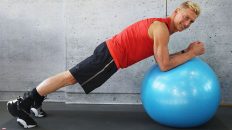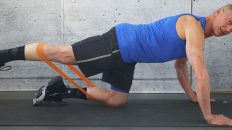Recovery refers to techniques and actions taken to maximize your body’s repair. These include hydration, nutrition, posture, heat, ice, stretching, myofascial release, stress management, and compression. While recovery is multifaceted and encompasses more than just muscle repair, in this article we’ll talk only about the recovery techniques used by David in his release workouts.
What is Myofascial Release
Myofascial release, also known as “foam rolling,” has transformed from a once mysterious technique used only by professional athletes, coaches, and therapists to a familiar everyday practice for people at all levels of fitness. Recent information, technology, and affordable products have introduced an increasing array of training and recovery methods to the average person.
Myofascial release is a fancy term for self-massage to release muscle tightness or trigger points. This method can be performed with a foam roller, tennis ball, or your own hands. By applying pressure to specific points on your body you are able to aid in the recovery of muscles and assist in returning them to normal function. Normal function means your muscles are elastic, healthy, and ready to perform at a moment’s notice.
When rolling or working on tight/sore muscles you will experience discomfort or pain. Think of it like the pain you get while stretching. It should be uncomfortable, but not unbearable, and when you are done it should feel better. It is always recommended to consult with your physician or physical therapist for therapeutic/sharp pain and receive approval before starting self-myofascial release. For most people you will be cleared immediately and your doctor will encourage the practice.
How Does Myofascial Release Work?
Deep compression helps to break up or relax tight muscles and adhesions formed between muscle layers and their surroundings. Imagine you are tenderizing your own muscles. They should be soft and supple like a baby’s muscles. However, if our muscles are not taken care of properly we can experience loss of flexibility, adhesions, and painful movement.
The deep compression of self-myofascial release allows normal blood flow to return and the restoration of healthy tissue. The body naturally wants to be healthy and strong, but sometimes an extra boost is needed to achieve optimal muscle and tissue health.
To foam roll properly, apply moderate pressure to a specific muscle or muscle group using the roller and your bodyweight. You should roll slowly, no more than one inch per second. When you find areas that are tight or painful, pause for several seconds and relax as much as possible. You should slowly start to feel the muscle releasing, and after 5-30 seconds the discomfort or pain should lessen.
If an area is too painful to apply direct pressure, shift the roller and apply pressure on the surrounding area and gradually work to loosen the entire area. The goal is to restore healthy muscles – it is not a pain tolerance test. You may also use other objects to work on muscles such as a tennis ball, lacrosse ball, Theracane, or Trigger Point Therapy Kit.
Never roll a joint or bone. Avoid rolling your lower back. To target these muscles I recommend using tennis or lacrosse balls. If you are having issues with your neck, refer these issues to an appropriate medical professional, as these areas they can be more sensitive and require more advanced attention.




